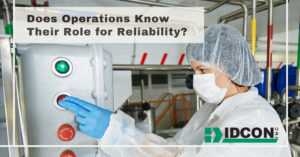In this and following columns, I will elaborate concerning the vital relationship between operations, maintenance, and engineering.
In this first column, I will focus on the relationship between operations and maintenance. I have written about this before, but the question has come up very frequently in the last year, so it is worth repeating some of the information.
From my experience, it is more common than not to find that the working relationship between operations and maintenance is one of adversity instead of a relationship of close and productive cooperation.
Operations often sees itself as the customer of maintenance, and, consequently, maintenance is viewed as a service provider.
In such a relationship, it should be obvious that operations is responsible for the cost of the maintenance work it requests and gets delivered. However, in a bad relationship, this is not the case.
As long as maintenance work requests are performed, operations views maintenance as the good guys.
But, if at the end of the year it shows that the maintenance budget is exceeded, it is not unusual to find the maintenance manager in the hot seat having to explain why more money than budgeted was spent.
In a customer/service-supplier relationship, it is also common to find that priorities are very emotional. The customer wants something done and the service supplier says “yes, sir” and does its best to deliver.
This is often done even if the service supplier knows that there is more important work to do instead of the work it was requested to do.
I could go on with many other issues that result from this type of relationship, including lack of trust, poor communication, and finger-pointing when problems occur, etc.
However, I will instead focus on what you should do to improve this relationship.
AGREE ON THE SAME GOAL.
Ask yourself what the business of maintenance is and what the business of operations is.
We could have a lengthy discussion around this, but common sense dictates one conclusion: If you manufacture pulp or paper, your common goal must be that both departments are equal partners in manufacturing your product in the most cost-effective manner.
This soon comes down to the following formula:
Time Efficiency x Quality Performance x Speed Performance, which is often called Overall Equipment Efficiency (OEE)
However, I suggest you change the name to Overall Production Efficiency (OPE).
Why? Because you need to express clearly that both departments do have one and the same goal.
You will no longer talk about lost production by departments in a finger-pointing manner. Instead, your focus should be root cause problem elimination.
This is an important change since it is not enough to just say, “Okay, from now on we are partners instead of customer/suppliers.” Next, you make friends and do some teamwork training, etc.
You must also change the way your processes work.
To change from OEE to OPE means that you also must abandon the practice of categorizing lost production by department—for example, by mechanical, electrical, instrumentation, and operations.
If you still do your production reports this way (which 95% of the industry in fact does), you break a ground-rule when you try to get people to work together by asking “who?” instead of “why?”.
I suggest you instead implement the following process:
- Collect problems that have caused high costs in safety, environmental, lost production (quality, time, speed), or problems causing high maintenance costs.
- Select which problem(s) to solve.
- Assign a problem owner to the selected problem.
- Problem owner selects a team to help solve the problem.
- Solve the problem.
- Document the solution.
- Educate the rest of the organization in the solution.
If you truly did more of the above, instead of wasting energy and time on guessing which department is to blame, you would have started autonomous education and training.
You will also remove one of the barriers that keep you from working better together.
Soon, you will also see that problems are not always classifiable by department, because the root cause to the problem is often a mix of how you operate the equipment and/or the process and how you maintain it.
part2 | part 3 | part4 | part5




